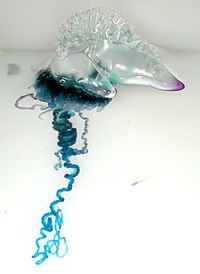
Photo from wikipedia
The use of biodiesel can reduce dependence on diesel, and the compression ignition (CI) engine's performance with biodiesel is substantially low but could be improved by emulsifying nano-additives. Biodiesel production… Click to show full abstract
The use of biodiesel can reduce dependence on diesel, and the compression ignition (CI) engine's performance with biodiesel is substantially low but could be improved by emulsifying nano-additives. Biodiesel production and performance in CI engines using a homogeneous catalyst is less efficient, expensive, and time-consuming. In this research article, magnesium-doped calcium oxide (Mg–CaO), a novel heterogeneous nanocatalyst, was synthesized and then used to generate biodiesel from Sapindus trifoliatus seed oil. The catalyst surface characterization was analyzed using the surface imaging method, energy dispersive x-ray analysis, x-ray diffraction analysis, and Fourier-transform infrared spectroscopy. Then, the nanocatalyst (30 ppm Mg–CaO) is emulsified in its nano form with the Sapindus trifoliatus biodiesel (STBD) at B25 (STB25% + diesel75%) blend and investigated in the CI engine. The highest yield of 91.75% of biodiesel was achieved at 58 °C, 73 min, 4% catalyst concentration (w/w), and 15:1 methanol:oil molar ratio. The performance results were obtained using STBD25, STBD25 blended with CaO nano-additives (STBD25 + 30 ppm CaO) and STBD25 blended with Mg-doped CaO nano-additives (STBD25 + 30ppm Mg–CaO) are compared to the baseline values obtained from diesel. From the comparison, it is revealed that STBD25 + 30ppm Mg–CaO has a greater influence on combustion, performance, and emission characteristics as follows: (i) in-cylinder pressure increased by 3.22%, 6.24%, and 9.02%, (ii) heat release rate increased by 1.68%, 16.69%, and 32.5%, (iii) brake thermal efficiency is found to be increased by 4.56%, 8.23%, and 11.79%, (iv) hydrocarbon (HC) decreased by 21.12%, 6.06%, and 11.43%, (v) carbon monoxide (CO) decreased by 0.04%, 0.01%, and 0.01%, and (vi) smoke decreased by 22.61%, 8.11%, and 14.25%, compared with diesel, STBD25 + 30 ppm CaO, and STBD25 at full load conditions. Oxides of nitrogen (NOx) released while using STBD25+Mg-doped CaO in CI engine were observed to decrease compared with STBD25 and STBD25+CaO (by 10.72% and 18.64%) and an increase compared with diesel (by 8.64%).
Journal Title: Journal of Renewable and Sustainable Energy
Year Published: 2023
Link to full text (if available)
Share on Social Media: Sign Up to like & get
recommendations!